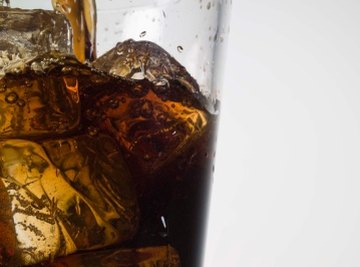
With so many different sugar-filled drinks on the market, discovering the actual make up of any one of them can be an interesting science project. Even without lab equipment to separate the sodas, less sophisticated methods can be used to compare sugar content of soft drinks to each other and to other beverages and foods on the market.
Boil Away the Water
You'll need a scale, small pot, a camera and some graphing paper to document an experiment where you boil away the water content in soda to leave only the sugar. After weighing the soda on a scale, place the soda in a small pan on a stove top and lightly boil it until all the water evaporates to leave the sugar syrup. Measure the sugary syrup again on the scale, making sure to measure in grams. Document the at-home experiment by photos and graphs, showing comparison pictures side by side of the amount of sugar left in each pan and recording exactly how many were grams weighed out. Include cans of soda with any project to show how close home measurements are to the measurement of grams on the can.
Convert Grams to Teaspoons
The grams that are listed on the back of a soda container measure weight, while teaspoons or tablespoons measure volume, but there is a way to demonstrate how many teaspoons or tablespoons are there. Using a piece of paper or parchment paper, calibrate a scale to measure in grams. If a can of soda says 39 g of sugar are in each serving, measure out 39 g of sugar. Funnel the sugar off of the paper and into an adjustable measuring spoon to measure out how many teaspoons the amount of grams equals.
Compare Sodas Side by Side
After converting grams to teaspoons or tablespoons, another eye-opening demonstration is comparing those amounts. Place each can of soft drink next to another. In front of the cans, place a small container with the amount of granulated sugar corresponding to each soft drink. The eye will be able to see which drink contains more sugar than the others; the experiment could be extended to juice drinks and energy drinks as well.
Design a Comparison Experiment
An experiment that tests for the perception of sweetness can be made into a science project. Enlist friends or family to try different sodas and rank their sweetness or to try to tell the difference between natural and artificial sweeteners. To design an experiment, first design a hypothesis, which is what you think will happen. An example hypothesis would be "75 percent of people in this experiment will be able to tell which soda has more sugar in it." A list of materials, procedures and results should be included, and the conclusion should discuss whether what actually happened is what you thought would happen and why you think the results turned out the way they did.
References
About the Author
Sarah Thomsen started writing about health in 2006 while pursuing her associate degree in humanities and social sciences. Her published online articles focus on improving holistic health. She holds a Bachelor of Science in nutrition science with a minor in psychology from Russell Sage College and a Health Studies Certificate from Schenectady County Community College.
Photo Credits
Jupiterimages/Comstock/Getty Images
